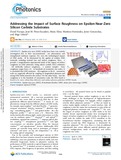Mostrar el registro sencillo del ítem
Addressing the impact of surface roughness on epsilon-near-zero silicon carbide substrates
| dc.creator | Navajas Hernández, David | es_ES |
| dc.creator | Pérez Escudero, José Manuel | es_ES |
| dc.creator | Martínez Hernández, María Elena | es_ES |
| dc.creator | Goicoechea Fernández, Javier | es_ES |
| dc.creator | Liberal Olleta, Íñigo | es_ES |
| dc.date.accessioned | 2023-10-20T09:38:24Z | |
| dc.date.available | 2023-10-20T09:38:24Z | |
| dc.date.issued | 2023 | |
| dc.identifier.citation | Navajas, D., Pérez-Escudero, J. M., Martínez-Hernández, M. E., Goicoechea, J., Liberal, I. (2023) Addressing the impact of surface roughness on epsilon-near-zero silicon carbide substrates. ACS Photonics, 10(9), 3105-3114. https://doi.org/10.1021/acsphotonics.3c00476. | en |
| dc.identifier.issn | 2330-4022 | |
| dc.identifier.uri | https://hdl.handle.net/2454/46599 | |
| dc.description.abstract | Epsilon-near-zero (ENZ) media have been very actively investigated due to their unconventional wave phenomena and strengthened nonlinear response. However, the technological impact of ENZ media will be determined by the quality of realistic ENZ materials, including material loss and surface roughness. Here, we provide a comprehensive experimental study of the impact of surface roughness on ENZ substrates. Using silicon carbide (SiC) substrates with artificially induced roughness, we analyze samples whose roughness ranges from a few to hundreds of nanometer size scales. It is concluded that ENZ substrates with roughness in the few nanometer scale are negatively affected by coupling to longitudinal phonons and strong ENZ fields normal to the surface. On the other hand, when the roughness is in the hundreds of nanometers scale, the ENZ band is found to be more robust than dielectric and surface phonon polariton (SPhP) bands. | en |
| dc.description.sponsorship | I.L. acknowledgessupportfrom Ramón y Cajal fellowshipRYC2018-024123-Iand projectRTI2018-093714-301J-I00sponsoredby MCIU/AEI/FEDER/UE,and ERC StartingGrant 948504. | en |
| dc.format.mimetype | application/pdf | en |
| dc.language.iso | eng | en |
| dc.publisher | American Chemical Society | en |
| dc.relation.ispartof | ACS Photonics, 2023,10, 3105-3114 | en |
| dc.rights | © 2023 The Authors. This article is licensed under CC-BY 4.0 | en |
| dc.rights.uri | http://creativecommons.org/licenses/by/4.0/ | |
| dc.subject | Atomic force microscopy (AFM) | en |
| dc.subject | Epsilon-near-zero (ENZ) | en |
| dc.subject | Fourier transform infrared (FTIR) | en |
| dc.subject | Kretschmann-Raether | en |
| dc.subject | SPhP | en |
| dc.title | Addressing the impact of surface roughness on epsilon-near-zero silicon carbide substrates | en |
| dc.type | Artículo / Artikulua | es |
| dc.type | info:eu-repo/semantics/article | en |
| dc.date.updated | 2023-10-20T08:06:01Z | |
| dc.contributor.department | Ingeniería Eléctrica, Electrónica y de Comunicación | es_ES |
| dc.contributor.department | Institute of Smart Cities - ISC | en |
| dc.contributor.department | Ingeniaritza Elektrikoa, Elektronikoaren eta Telekomunikazio Ingeniaritzaren | eu |
| dc.rights.accessRights | Acceso abierto / Sarbide irekia | es |
| dc.rights.accessRights | info:eu-repo/semantics/openAccess | en |
| dc.identifier.doi | 10.1021/acsphotonics.3c00476 | |
| dc.relation.projectID | info:eu-repo/grantAgreement/AEI/Plan Estatal de Investigación Científica y Técnica y de Innovación 2017-2020/RYC2018-024123-I | en |
| dc.relation.projectID | info:eu-repo/grantAgreement/AEI/Plan Estatal de Investigación Científica y Técnica y de Innovación 2017-2020/RTI2018-093714-301J-I00/ES/ | en |
| dc.relation.publisherversion | https://doi.org/10.1021/acsphotonics.3c00476 | |
| dc.type.version | Versión aceptada / Onetsi den bertsioa | es |
| dc.type.version | info:eu-repo/semantics/acceptedVersion | en |



